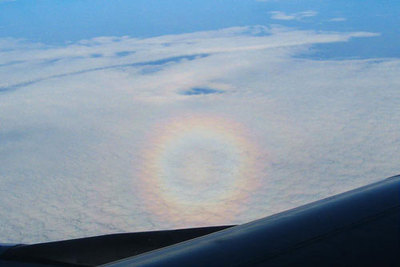 |
|
Glory. The Glory mission gets its name from an optical phenomenon that's observable when water droplets backscatter light. Glories look like small, circular rainbows of interlocking colors. This glory was photographed from a plane over South Africa. Credit: Earth Science Picture of the Day / Raquel Yumi Shida
|
| |
The Glory spacecraft, set to launch no earlier than
February 2011, will study
how the sun and airborne particles called aerosols affect Earth's climate.
Scientists have a thorough understanding of how greenhouse gases impact the energy budget, but the roles that two other critical elements of the climate system - the sun's
total solar irradiance (TSI) and
atmospheric aerosol particles - play are somewhat less certain.
The Glory mission, which contains two key scientific instruments, will improve understanding of both.
One of these instruments - the
Aerosol Polarimetery Sensor (APS) - will offer scientists new measurements of aerosols, which can affect climate by either absorbing or reflecting light depending on their type.
The unique instrument measures polarized light to make aerosol measurements and should thus help scientists distinguish between aerosols types, such as dust and black carbon, from space.
The other instrument, the
Total Irradiance Monitor (TIM), will continue a long-running record of the sun's brightness with unprecedented accuracy.
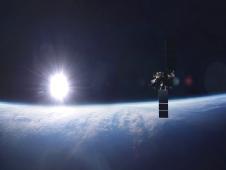 |
An artist's rendering of the Glory spacecraft.
Credit: NASA/GSFC/Ryan Zuber |
| |
Results from both instruments will be used to fine-tune global climate models and to help scientists predict how climate change will impact different regions of the planet.
Glory will join a fleet of other
Earth observing satellites known as the
A-Train. It is scheduled to launch aboard a
Taurus XL launch vehicle no earlier than
February 2011.
Missing Chapters of the Climate Story
Every second, millions of tons of hydrogen fuse into helium in the sun’s core as part of a massive chain of thermonuclear reactions that yield the energy equivalent of billions of exploding hydrogen bombs.
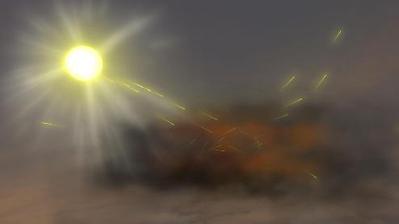 |
|
Many types of aerosol particles absorb incoming radiation from the sun, but darker-colored aerosols absorb radiation.
Credit: NASA
|
| |
This energy eventually makes its way to the sun’s surface and radiates outward in the form of light - some of it on a trajectory toward Earth.
http://www.nasa.gov/mission_pages/Glory/main/index.html
Mission Overview
The Glory mission, designed to improve
NASA's understanding of
Earth's climate system, is scheduled for launch no earlier than February 2011 aboard a
Taurus XL launch vehicle from
Vandenberg Air Force Base (VAFB), Ca.
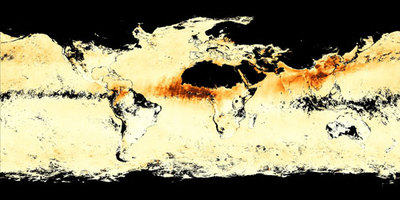 |
|
Aerosol Optical Thickness. Satellite instruments can track global aerosol levels. Though aerosols are fast moving and their distribution changes frequently, this graphic shows the average distribution of aerosols between March 2009 and 2010. Darker colors indicate greater levels of aerosols. Black indicates areas for which satellite data is not available.
Credit: NASA
|
| |
Glory will improve the understanding of aerosol contributions to global climate change and help maintain a record of total solar irradiance.
Data provided by the
Glory mission will enhance
global climate modeling and help
reduce uncertainties associated with the causes and consequences of
global climate change.
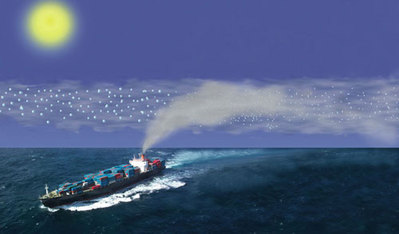 |
|
Aerosols and Ship Tracks. This schematic Illustration shows how aerosols from ship exhaust can result in a larger number of droplets in a given volume of cloud, but with smaller droplet sizes. Such changes can alter the onset of precipitation and cause clouds to appear brighter.
Credit: NASA
|
| |
Glory's Aerosol Polarimetry Sensor (APS) will collect information about atmospheric aerosols, such as the shape, composition, and reflectivity of different types of aerosol particles.
 |
|
Black Carbon Cloud Droplets. An artist's illustration shows how aerosol particles can serve as the seeds of cloud droplets. Credit: NASA
|
| |
The Total Irradiance Monitor (TIM) will monitor variations in solar activity by measuring the amount of radiation that strikes the top of
Earth's atmosphere.
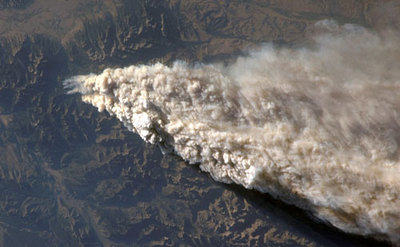 |
|
Fire Aerosols. Fires are one of many sources of aerosols. This image, captured by a NASA satellite, shows a plume of smoke from a wildfire burning over Idaho and Montana.
Credit: NASA
|
| |
Glory will join a fleet of
Earth observing satellites known as the
Afternoon Constellation, or "
A-Train", which together offer a more cohesive and detailed picture of the
Earth's biosphere and climate.
 |
|
Many Shades of Aerosols. Scientists study many types of aerosols such as sulfates, nitrates, dust, salt, black carbon. This image shows how aerosols come in numerous shades depending on their chemical composition.
Credit: NASA
|
| |
The Glory mission is collaborative effort involving
NASA, Orbital Sciences Corporation, Raytheon's Santa Barbara Remote Sensing (SBRS), and
University of Colorado's Laboratory for Atmospheric and Space Physics (LASP).
http://www.nasa.gov/mission_pages/Glory/overview/index.html
Spacecraft and Instruments
Two instruments aboard Glory - the
Aerosol Polarimetery Sensor (APS) and the
Total Irradiance Monitor (TIM) supply information about
critical components of Earth's climate system.
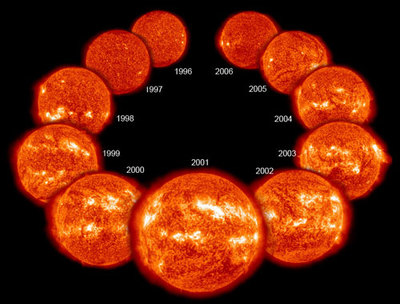 |
|
Solar Cycle. This montage of solar imagery shows that solar activity varies over time. During periods of high activity, the amount of radiation emit by the sun increases slightly.
Credit: NASA
|
| |
The APS, which is mounted on the underside of
Glory's bus and faces downward, collects information about aerosol properties.
TIM, which is located on the opposite side of the spacecraft and faces outward, measures the intensity of incoming solar radiation at the top of the atmosphere.
Aerosol Polarimetry Sensor (APS)
The concept for
APS stretches back to the 1970s when
James Hansen,
director of NASA’s Goddard Institute for Space Studies in New York, conducted studies on the polarization of light from
Venus.
By studying polarization - a measure of the physical orientation of light waves as they move and twist through space -
Hansen and his colleagues managed to deduce the composition of
Venus' clouds.
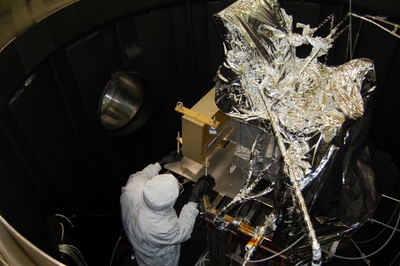 |
|
A view of Glory's Aerosol Polarimetry Sensor (APS) from inside the thermal vacuum chamber. Technicians wear garments -- known as "bunny suits" -- to protect the instrument from dust and other contaminants.
Credit: NASA
|
| |
The success of such efforts led scientists and engineers to develop similar instruments to study the
Earth.
In 1999,
NASA developed an aircraft-based polarimeter called the
Research Scanning Polarimeter (RSP) that has provided unprecedented detail about
Earth's aerosols.
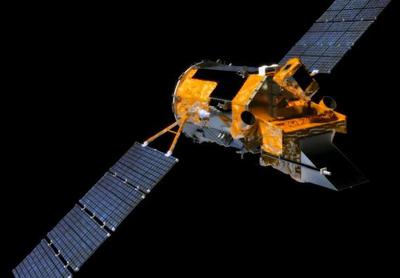 |
|
Glory's APS instrument is downward pointing, while the TIM instrument faces upward toward the sun.
Credit: NASA/GSFC/Ryan Zuber
|
| |
The Glory APS, which has a nearly identical design to the
RSP, will be
NASA's first polarimeter capable of studying terrestrial aerosols and clouds from space from more than
250 angles, using nine different spectral channels.
The
69 kg (152 lb) instrument views the
Earth's surface in
5.9-kilometer ground-track bands and repeats its measurements
cycle every 16 days.
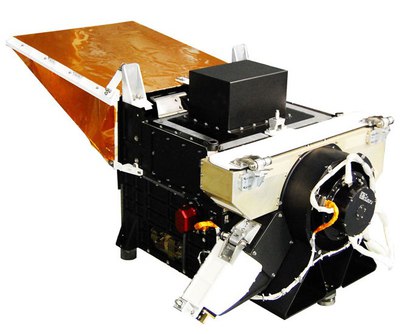 |
|
Aerosol Polarimetry Sensor. The Aerosol Polarimetry Sensor will study aerosols by observing how light behaves when scattered by the aerosol particles.
Credit: NASA
|
| |
Light that enters the
APS first passes a dual mirror assembly, a series of lenses that collect and focus the beams, and then gets split by a prism into two orthogonally polarized planes that nearby detectors can measure.
Glory carries secondary instruments called cloud cameras that will support the
APS by tracking clouds as they pass through the
APS' sights.
These cameras will help scientists identify partially cloudy scenes that require special analysis.
Total Irradiance Monitor
Though often mistakenly considered constant, the amount of incoming
solar radiation striking the top of
Earth's atmosphere actually fluctuates slightly as the sun cycles through periods of
more and less intense electromagnetic activity.
Glory's TIM instrument, a type of
radiometer called a bolometer, will maintain and improve what's now a decades-long record of
total solar irradiance.
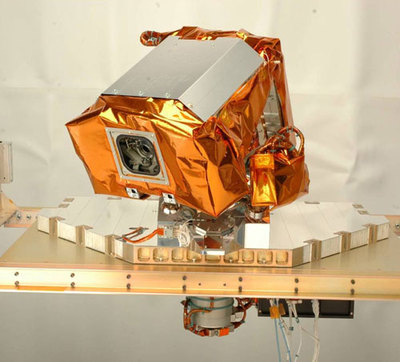 |
|
Total Irradiance Monitor. The Total Irradiance Monitor (TIM) tracks variations in the amount of electromagnetic radiation emitted by the sun.
Credit: NASA
|
| |
The TIM is an improvement of a similar instrument launched in 2003 as part the
Solar Radiation and Climate Experiment (SORCE) mission.
The Glory TIM, which was designed by the
Laboratory for Atmospheric and Space Physics (LASP) at the
University of Colorado, is designed to be 3 times more accurate than previous instruments.
In the past, subtle differences in the design and calibrations of
TSI instruments have caused noticeable offsets in the data.
In most cases, scientists have had to correct for such discrepancies by matching up data between overlapping missions.
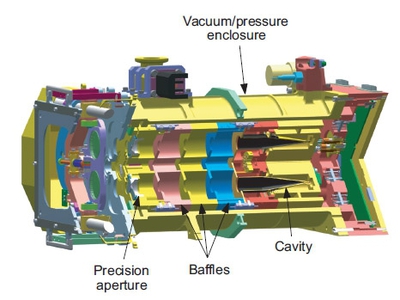 |
A cutaway of the TIM instrument shows black absorptive cavities that are used to measure total solar irradiance.
Credit: NASA / American Meteorological Society |
| |
While still important, overlapping missions will become less crucial than they previously were because the
Glory TIM has been calibrated at a new ground-based facility at
LASP called the TSI Radiometer Facility.
The TIM instrument contains four identical radiometers capable of
monitoring the sun during the daylight portion of each orbit. It sits on a gimbaled platform that allows mission controllers to aim it toward the sun independently of the orientation of the
spacecraft.
Scientists at LASP process the data
TIM gathers, and post it on the web for use in climate and solar science within days of acquisition.
Glory's Spacecraft
An octagonal aluminum chassis - or bus - serves as the foundation of the
Glory spacecraft. The bus is divided into two mains sections: a propulsion deck at the tail end of the spacecraft and a core deck in the middle.
Attached to the core deck, an irregularly-shaped instrument assembly board houses the mission’s two milk-crate sized science instruments, a pair of cloud tracking cameras, a communications antenna, and various other minor components.
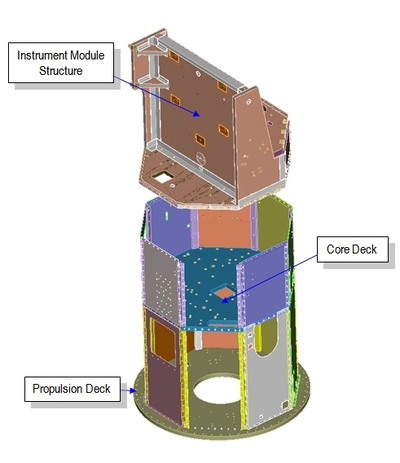 |
|
The Glory spacecraft is divided into three key sections: the propulsion deck, the core deck, and an instrument module.
Credit: NASA
|
| |
On the craft’s exterior, two rotating solar panels, Glory’s means of
generating electricity, protrude from the bus like wings.
Stripping away the panels that make up the bus reveal the guts of the
spacecraft.
On the propulsion deck, a large fuel tank is the most prominent feature.
The liquid propellant inside - a pungent substance called
hydrazine - gets piped to
four adjacent thrusters, which ground-based flight operators use to ease the craft into orbit and make occasional corrections to keep it on course.
The core deck is packed with various power control boxes, regulators, and an attitude control subsystem that determines the craft’s orientation in respect to the
Earth.
The placement of the
spacecraft’s battery, strategically put in the heart of the core deck facing
Earth,
protects it from temperature swings.
The attitude control system contains four geared reaction wheels that keep the spacecraft pointing directly downward - at nadir - even as aspects of the orbit change.
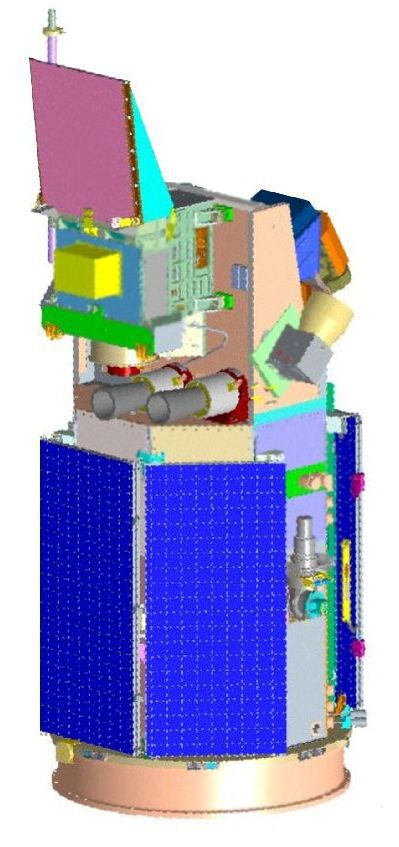 |
|
Roll over the spacecraft above to locate Glory's instruments.
Credit: NASA/GSFC
|
| |
In many respects, the
Glory spacecraft is fairly unremarkable in comparison to other
NASA earth observing satellites.
It isn’t the largest or the heaviest, nor does it carry the most scientific instruments.
At
1.9 meters (6.23 feet) by
1.4 meters (4.59 feet) -
Glory isn’t much taller than most people or wider than a large oil barrel.
Glory weighed 525 kilograms (1,158 pounds) at launch, about a tenth the mass of
NASA’s flagship earth observing
satellite Terra.
But there’s a key detail that makes
Glory quite unusual: the spacecraft’s bus was originally designed for the
Vegetation Canopy Lidar (VCL), a mission that
NASA canceled in 2000 due to a technical glitch in the development of an instrument.
Converting VCL - a spacecraft that would have flown in a different orbit, launched on a larger rocket, and faced slightly different conditions in space - into
Glory wasn’t always straightforward.
Many of the
original VCL bus components had to be replaced; the rest had to be recertified to meet the requirements of the new mission.
Telltale signs of
Glory’s unique pedigree still persist.
The spacecraft’s hydrazine thrusters are significantly larger, for example, than is typical for a mission of its size.
And the solar arrays, designed for a different orbit, have an unusual orientation - meaning the spacecraft appears to fly “
sideways” in orbit.
Yet four years after engineers first began
converting VCL into Glory, mission engineers aren’t losing sleep wondering whether
Glory will perform as well as a brand new
spacecraft.
Many rounds of tests that simulate the conditions the craft will face in space have proven that it should.
A four-stage, solid fuel rocket - a
Taurus XL built by
Orbital Science Corporation in Dulles, Virginia - will launch
Glory into orbit from
Vandenberg Air Force Base in California.
The spacecraft is to assume a place among a series of earth-observing satellites that track the same line over earth dubbed the
A-Train.
After launch, mission operators conduct verification tests for
30-day period and then begin normal data collection for a period of at least
three years.
Glory orbits in a low-earth orbit of
705 km (438 miles) altitude - about the distance between
Boston and
Washington, D.C.
http://www.nasa.gov/mission_pages/Glory/spacecraft/index.html
Glory Team
Project Manager
Bryan Fafaul
Project Manager
Goddard Space Flight Center
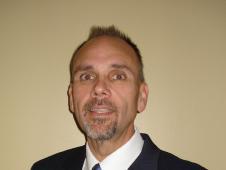 |
|
Bryan Fafaul
Credit: NASA
|
| |
Bryan Fafaul, the Glory Project Manager, has worked at the Goddard Space Flight Center for more than 22 years in a wide variety of technical and management positions.
Bryan started his career in Electrical, Electronic, and Electromechanical (EEE) Parts Branch and then moved into project management.
He has served as the Mission Manager for the Wide-Field Infrared Explorer (WIRE), the Hubble Space Telescope (HST) Instrument Systems Manager for Servicing Mission 3A, 3B and 4, the Deputy Project Manager for The NPOESS Preparatory Project (NPP), prior to his current position as the Glory Project Manager.
Deputy Project Manager
Steven Pszcolka
Deputy Project Manager
Goddard Space Flight Center
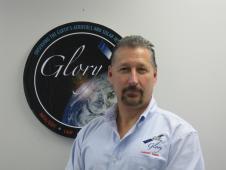 |
|
Steven Pszcolka
Credit: NASA
|
| |
Since May 2005, Steven Pszcolka has been the Deputy Project Manager for the Glory Project at NASA’s Goddard Space Flight Center (GSFC).
Prior to Glory, he was the Observatory Manager and Contracting Officer Technical Representative (COTR) for the spacecraft component of the Polar Operational Environmental Satellites Project for the development, integration, test and successful launch of NOAA-M and N and the development, integration and test of NOAA-N-Prime.
He has served as the Instrument Manager/COTR for the Advanced Very High Resolution Radiometer (AVHRR), which successfully launched on NOAA-L, and he was a Spacecraft Subsystem Manager/COTR for the Solid State Recorder (SSR) & Digital Tape Recorders (DTR), which successfully launched on NOAA-K.
He has also served as the Deputy Observatory Manager for the Global GeoSpace (GGS) Polar Spacecraft. He started his career at GSFC in the Electrical, Electronic, and Electromechanical (EEE) Parts Branch where he implemented the first successful Common Buy of EEE parts at GSFC for multiple flight projects.
Additionally, he has served on numerous Tiger Teams over the years at GSFC.
Most notably are the efforts as the Tiger Team lead for the recovery from the overstress event of the GGS Polar Spacecraft, the rework of NOAA-K DTR’s, implementation of a board development and test program for the CDS/VDS instrument (ISTP Cluster spacecraft) and the development, test and successful integration of a Ground System in Europe for the MetOp Program.
Pszcolka has a Bachelor of Science Degree in Electrical Engineering from Lawrence Institute of Technology and a Master’s of Science in System Engineering / Management from The John’s Hopkins University.
Deputy Project Manager/Resources
Kevin Miller
Deputy Project Manager/Resources
Goddard Space Flight Center
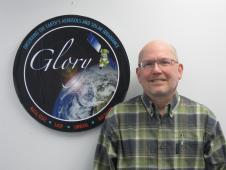 |
|
Kevin Miller
Credit: NASA
|
| |
Kevin Miller is the Deputy Project Manager/Resources (DPM/R) for the Glory Project at NASA’s Goddard Space Flight Center (GSFC).
In this capacity, he is responsible for the development and management of project management systems, budgets, and personnel for this project.
Prior to this position, Miller served NASA in numerous capacities including: DPM/R on the Laser Interferometer Space Antenna (LISA) Project, Earth Observing -1 (EO-1) Project and the Geostationary Operational Environmental Satellite (GOES N Series) Project, Financial Manager on the Hubble Space Telescope (HST) Development Project, the Project Support Manager for the Polar Operational Environmental (POES) Program and the International Solar Terrestrial Physics Project, and Resources Analyst for the Geostationary Operational Environmental Satellite (GOES) Program and the Earth Observing Satellites (EOS) Program. He served in a series of rotations as both a resources and budget analyst as a Presidential Management Intern.
Miller has a B.A. degree in History and an M.A. degree in Public Affairs from the University of Minnesota.
He has graduated from the GSFC’s Flight Programs and Projects Directorate’s Project Management Development Emprise (PMDE) Program, is a Senior Executive Fellow of the Harvard University’s Kennedy School of Government, and is a certified Project Management Professional (PMP).
Miller is a member of the Program Management Institute (PMI) and the Society of Cost Estimating and Analysis (SCEA).
Project Scientist
Michael I. Mishchenko
Project Scientist
Goddard Institute for Space Studies
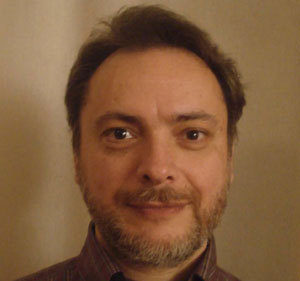 |
|
Michael I. Mishchenko
Credit: NASA
|
| |
Michael I. Mishchenko is a Senior Scientist at the NASA Goddard Institute for Space Studies (GISS) in New York City and the Project Scientist for the NASA Glory Satellite Mission.
After graduating from the Moscow Institute of Physics and Technology in 1983, he gained his PhD and Habilitation Doctoral degrees from the Main Astronomical Observatory (MAO) of the National Academy of Sciences of Ukraine (NASU, Kyiv) in 1987 and 2008, respectively.
He worked in MAO from 1987–92 and has been at GISS thereafter.
Mishchenko has been Principal Investigator on several NASA, NOAA, and DoD research projects and has served as Topical Editor and Editorial Board member of such leading scientific journals as Applied Optics, Kinematics and Physics of Celes-tial Bodies, Journal of the Atmospheric Sciences, Journal of Quantitative Spectroscopy and Radiative Transfer, Journal of Electromagnetic Waves and Applications, and Waves in Random and Complex Media.
Since 2006 he has been Editor-in-Chief of the Journal of Quantitative Spectroscopy and Radiative Transfer.
Mishchenko was a Project Manager for the NASA/WCRP Global Aerosol Climatology Project (1998–2002) and has been the Glory Project Scientist since 2003.
He has published four monographs (with Cambridge University Press, Academic Press, and Springer), 16 peer-reviewed book chapters, and 190 peer-reviewed journal papers. He has (co)organized 6 International conferences and served as Guest Editor for 7 special journal issues.
He is a recipient of the N. P. Barabashov Award of the NASU, the Henry G. Houghton Award of the American Meteorological Society, the Arthur S. Flemming Award of the George Washington University, the NASA Exceptional Scientific Achievement Medal, and 11 other NASA awards. In 2009 asteroid 22686 (1998 QL53) was named “Mishchenko”.
Mishchenko is a Vice-President of the Ukrainian Astronomical Association, an elected member of the Council of the Ukrainian Academy of Arts and Sciences in New York, and an elected Fellow of the American Geophysical Union, the Optical Society of America, The Institute of Physics, and the American Meteorological Society. His research interests have included electromagnetic scattering, radiative transfer, and remote sensing.
APS Instrument Manager
Jeff Hein
APS Instrument Manager
Goddard Space Flight Center
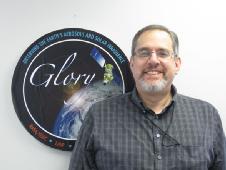 |
|
Jeff Hein
Credit: NASA
|
| |
Jeff Hein serves as the Aerosol Polarimetry Sensor (APS) Instrument Manager for the GLORY Project.
His responsibilities include defining operational requirements, researching, developing, performing analysis, integrating, and evaluating satellite systems as a part of the development of the APS Instrument.
Hein began his career at GSFC as a co-op student, and then, upon graduation, as the engineering lead for the deployable Thermal/RF Shield on the COBE satellite.
Prior to flight instrument work, he was a systems engineer on Space Shuttle and Space Station Projects from 1989-1994 at the Johnson Space Center.
This included serving as the Development and Test (DTO) Systems Engineer for a small 100 lb. jet pack, called the Simplified Aid for EVA Rescue (SAFER), which flew on STS-64.
Hein returned to GSFC in 1994 to continue human spaceflight work in the Hubble Space Telescope Servicing Missions Project, as an EVA Development Manager.
Hein has been an Instrument Manager at GSFC for the past 12 years, serving various missions, such as CALIPSO (GSFC Mission Systems Engineer for Instruments), LISA, JWST (ISIM Manager and NIRSpec MSA Instrument Manager), the Lewis Multi-spectral Imager Re-flight, GLAST, and Constellation-X, and GSFC mission proposals (COBRA, SPACE, Horizon, Solar Probe, and Sea Surface Salinity).
APS Instrument Scientist
Brian Cairns
APS Instrument Scientist
Goddard Institute for Space Studies
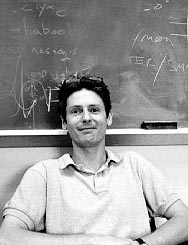 |
|
Brian Cairns
Credit: NASA
|
| |
Since 2007, Brian Cairns has been a scientist with the National Aeronautics and Space Administration (NASA) at Goddard Institute for Space Studies (GISS) in New York City.
In this post, he has worked on the development of the Aerosol Polarimetry Sensor (APS) and the Cloud Cameras (CCs) for the NASA Glory mission and serves as instrument scientist for these instruments.
The APS sensor follows on from a similar aircraft instrument, called the Research Scanning Polarimeters (RSP), that Cairns developed in collaboration with SpecTIR Corp., Ed Russell and Dick Chandos.
The RSP has flown in numerous NASA field experiments from the Arctic Circle to the deep tropics and has allowed Brian and his collaborators at GISS to gain a valuable understanding of what the APS data from Glory will look like.
He is also the developer of the data processing system for the APS and cloud camera data at GISS that will derive the geophysical products from the APS and cloud camera data.
He and his colleagues at GISS perform research on advanced numerical techniques for retrieving information from multi-spectral and multi-angle data that are being used in this data processing system.
Cairns is an adjunct professor with both Columbia University and the City College of New York with which institutions he has developed many enjoyable educational projects related to building simple instruments and analyzing remote sensing data.
In his spare time, Cairns enjoys hiking and rock climbing - at least once a year whether he needs to or not.
Brian grew up in Chesterfield in the United Kingdom and now lives in Cold Spring, NY with his wife, Valerie, and children, Philip and Alexandra.
TIM Instrument Scientist
Greg Kopp
TIM Instrument Scientist
Laboratory for Atmospheric and Space Physics
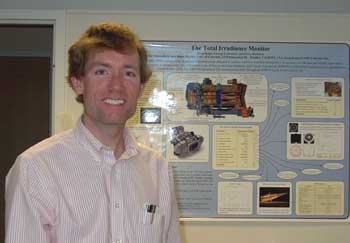 |
Greg Kopp
Credit: NASA |
| |
Greg Kopp, the TIM Instrument Scientist for the Glory mission, is an experimental solar physicist and instrumentation scientist.
He's a specialist in radiometry, interferometry, electro-optics, and infrared systems, as well as satellite, airborne, and ground-based facility instrumentation.
Kopp has worked at the Laboratory for Atmospheric and Space Studies at the University of Colorado, Boulder for 9 years.
His mission experience includes: Glory/TIM Principal Investigator and Science Team lead, Hyperspectral Imager Instrument Incubator Program Principal Investigator, TSI Radiometer Facility Principal Investigator, SORCE Co-Investigator and TIM Instrument Scientist, NPOESS/TSIS/TIM Instrument Scientist and NPOESS/TSIS OAT member, CLARREO Science Team Working Group member, NORM ISS instrument collaborator, GOES-R XRS Instrument Scientist (2005 Formulation Phase), Kepler planetary transit star field simulator demonstration PI (2002), Leading international effort to resolve total solar irradiance accuracy issues.
Kopp received his B.S., honors degree from California Institute of Technology and his Ph.D from Stanford University.
http://www.nasa.gov/mission_pages/Glory/team/index.html
ASTROMAN magazine

